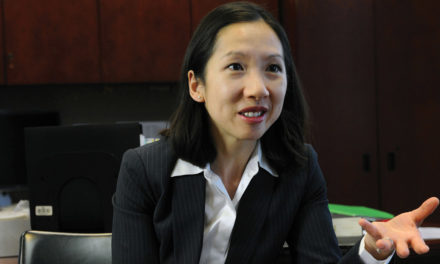On Election Night last November, much of the country went to pot.
Voters in California, Maine, Massachusetts and Nevada passed proposals to legalize recreational marijuana, bringing to eight the total number of states to do so (joining Alaska, Colorado, Oregon and Washington). Florida, Arkansas, Montana and North Dakota did the same for purportedly medical purposes.
All this, with polls showing rising national support for legalized marijuana—57 percent, in an October 2016 Pew Research survey—left pro-pot backers feeling high. “This is the most important moment in the history of the marijuana-legalization movement,” crowed Tom Angell, founder of the group Marijuana Majority.
But one state was an exception.
In Arizona, voters shot down Proposition 205, which would not only have legalized recreational marijuana, but elevated its use to a statutory right—going further than any state in the country to create a host of protections for the drug’s use. The measure was defeated, 51.3 to 48.7 percent.
What made that result more remarkable is that, just a few months earlier, polls showed Prop 205 had roughly a 12 percent lead, translating to a 300,000-vote cushion. The measure seemed a sure bet to sail through.
That’s what Cathi Herrod, president of the Center for Arizona Policy (CAP)—Focus on the Family’s public-
policy partner in the state—was expecting.
“In August, it looked like this was going to pass easily,” Herrod says. “There was no doubt about it.”
So how were Prop 205 opponents able to turn the tide? In a word, Herrod says, leadership.
She credits elected officials like Maricopa County Attorney Bill Montgomery and Yavapai County Attorney Sheila Polk. “They were very engaged early on, laying the foundation for the campaign,” Herrod says. “They could bring in the law-enforcement aspects of what has happened when marijuana was legalized and talk about the dangers.”
She credits Gov. Doug Ducey for playing a pivotal role no one else could play. “He jumped into the campaign (against Prop 205) 100 percent in the summer,” Herrod says. “Not only was he publicly vocal, he became the primary fundraiser”—helping the No on 205 group raise much of the $6 million or so it took in, and equipping them to compete with the deep-pocketed drug-legalization movement.
But Herrod also credits a lot of people outside electoral politics—including anti-drug activists, pastors and her CAP colleagues.
By the time Arizona’s neighboring state, Colorado, legalized recreational marijuana in a 2014 ballot measure, Herrod figured her state would be next—and started gearing up for the battle.
“In January 2015, our board of directors amended our strategic plan to add substance abuse as one of our key issues,” she says. “We saw this coming down the pike.”
What she and her colleagues didn’t know yet was just how bad Prop 205 would be.
Truth and Consequences
The proposal was billed as a moderate, carefully crafted measure that somehow would lead to a more stable society. The Yes on 205 group called itself the Campaign to Regulate Marijuana Like Alcohol. Advertising sold the idea that 205’s tax on marijuana would be used for education.
But as 205’s opponents dug into its language, the more red flags they saw.
“Prop 205 was about 20 pages long if you printed it out,” Herrod says. “A judge awarding parenting time (in child-custody battles) would not be able to consider marijuana use in the home. If a police officer pulled over someone driving erratically, it would be almost impossible to get them for DUI. The problems piled up. It was one thing after another that was wrong with this measure.”
And as problems piled up, so did opposition. The Arizona Chamber of Commerce joined the campaign against the measure, which would have placed new burdens on employers. They wouldn’t have been able to fire or penalize employees solely for being high: They’d have had to prove he was not only “impaired,” but had committed “negligence” or “professional malpractice.”
Another major drawback: Where other states allowed local communities to opt out of pro-marijuana measures—as many communities have—Arizona would have effectively forbidden it.
“Prop 205 did that in a very sneaky way,” says CAP Communications Director Cindy Dahlgren. “It said communities could opt out—unless they already had medical– marijuana dispensaries. And lo and behold, every one of them did. So in effect, you can’t opt out.
“That was one of the big things that turned people against 205. There were some whose attitude toward legalization was ‘Oh well, no big deal.’ But when they found out the pot shops were going to pop up in their local neighborhood, they didn’t like that at all.”
Those and other problems with Prop 205 were bad enough. Worse, by Arizona law, they would have been locked in permanently. Under the state constitution, legislators cannot modify any voter-approved measure with less than a three-fourths vote—and even then, only if it “furthers the purpose of the measure.”
“That means that if problems crop up after the measure passes, it’s almost impossible to fix them,” Herrod says. “The measure couldn’t be reined in later, only strengthened.”
And problems definitely would have popped up, Dahlgren says.
“In Colorado and Washington state, little kids were accidentally eating marijuana in candy form, which looks like gummy bears,” she notes. “Some of them were ending up in intensive care. So both states’ legislatures banned the candy. We wouldn’t have been able to do that here. We couldn’t make any adjustments.”
All this was more than enough to give voters second thoughts. The No on 205 campaign’s job was to get the word out.
“We had an air war—TV ads, personal stories of people who’d been harmed by recreational marijuana,” Herrod says. “And we had a ground war, a grassroots effort.”
While different groups specialized in different aspects of the campaign, the ground war was CAP’s specialty. So that’s where they focused the lion’s share of their efforts.
The Church Awakens
Even before the battle over Prop 2005 began, Arizona’s anti-drug groups learned a lesson from their neighbor’s mistake—and resolved not to let it happen in their state.
“Two or three months before Prop 205 was introduced, I was invited to speak to a group of pastors in Denver,” says CAP Community Relations Director Obed Escobar. “Pastors were saying, ‘We didn’t do enough to stop marijuana in our state.’ They’d thought a law like that would never pass.
“So when I returned to Arizona, I told that story to a group of pastors, and said, ‘Let’s not make the same mistake. It’s time to get involved.’ Pastors were very open to that message. It lit a spark.”
Escobar, a former pastor himself, helped to make sure that the church coalition was a broad, multi-ethnic one. His ethnic background and fluency in Spanish was a valuable asset.
“We spoke at churches and we went to the media, places like Univision and Telemundo,” he says. “The Hispanic community gave us a great reception. We had people who usually don’t stand with conservatives on many issues, but who supported us because of the impact this measure would have had on kids.”
And CAP staffers weren’t the only ones spreading the word in churches. Take Debbie Moak, director of the Governor’s Office for Youth, Faith and Family.
“We reached out to Cathi Herrod and CAP and made a plan to reach as many pastors and churches as we could,” Moak says. “There were Sundays that I was in five churches, one after the other. When people heard what we were saying, they got on board.”
Moak was highly motivated to put in many hours trying to stop Prop 205. She’s been fighting drug abuse for 17 years—ever since she had to put her son into rehab at age 20.
“We became aware when he was 15 that he’d smoked pot for the first time on a student-government trip, when a beautiful senior cheerleader asked if he wanted to get high,” Moak says. “That started us down a very long road that we never thought we’d be on. We had to work very hard to save our son’s life as he went on to become a full-blown addict by age 20.”
Debbie and her husband, Steve, founded notMYkid, a nonprofit group providing prevention, education and early intervention services. In 2015, she joined Ducey’s administration—“to do for the state of Arizona much of what I’d spent the last 17 years doing,” she says.
For legal reasons, Moak wasn’t allowed to work against Prop 205 during business hours. So she did it on her own time.
“You’d find me out dealing with this issue almost every evening for about a year and a half, as well as on weekends,” she says, adding that Ducey often did the same.
‘They Caught Fire’
In the months leading up to November, many pastors took up the cause of stopping 205. One pastor, however, was in a unique position to motivate his peers—because of his personal experience.
Mark Buckley, founder of Living Streams Church in Phoenix, had used marijuana in high school in the 1960s. And he paid a price.
“I experienced a lot of ongoing emotional problems as a result,” Buckley says—“a loss of initiative, a spiritual confusion and darkness that led me to experiment with other drugs and eventually end up in a mental institution.
“I came to know Christ when I was 20. But even after I gave my life to Jesus and my sins were forgiven, my brain was still damaged. It took a number of years for my mind to be renewed and to recover from the effects of the drugs I’d taken.”
In September, Ducey met with a large group of pastors from across the state—many representing some of the most populous churches. There, Buckley shared his story. And his story made an impact, Herrod says.
“He stood up and basically said, ‘Men, this is a kingdom issue. You can’t be a good husband and be stoned. You can’t be a good worker and be stoned,’ ” she recalls.
“I saw (the pastors’) reaction. When they heard from Pastor Buckley, and from the governor, it moved them—to speak out from the pulpit, to have speakers at their churches, to host information nights.”
As the election drew nearer, polls grew tighter. But the numbers still tended to narrowly favor Prop 205. Its opponents knew that the energy they were seeing in the churches—and in the grassroots in general—would have to push them over the top.
“People took this issue seriously,” Herrod says. “They wanted to know what they could do. They wanted the yard signs. They wanted information to share.”
“We saw it on our own staff. We have a pretty good demographic mix, from ages 22 to 60. We had people who were against Prop 205, but were lukewarm about it at first. But as they learned how bad it was, they caught fire.”
As it turned out, that energy was essential. On Election Day, Prop 205 lost by 67,000 votes—an incredible turnaround from its one-time apparent 300,000-vote advantage.
“I prayed on this initiative day in and day out,” Moak says. “It was a remarkable victory.”
And, perhaps, one that can be a model for other states—if some political leaders are truly willing to lead. If business leaders and others are willing to raise the funds. And if spiritual leaders are willing to take a stand.
Buckley is especially passionate about that last part.
“We need to strengthen the resolve of pastors in our nation,” he says. “A lot of them feel like these trends are inevitable, so why bother to resist them?”
Buckley has an answer.
“Yesterday I did a memorial service for a 29-year-old who started using drugs in high school and committed suicide because his life was going nowhere,” he says. “It’s tragic. It’s heartbreaking. And it’s increasingly a reality in our society.
“We need to prepare our people to fight back. They need to have a firm resolve, because the consequences of doing nothing are too serious.”
For More Information:
To learn more about the Center for Arizona Policy,
visit https://www.azpolicy.org.
Originally published in the April 2017 issue of Citizen magazine.






